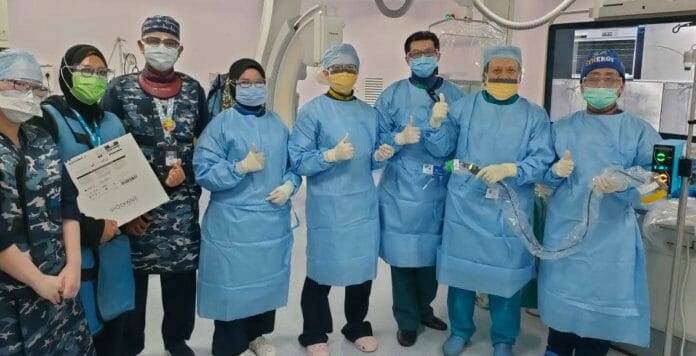Institut Jantung Negara (IJN) has revealed a newer and safer method to treat heart patients suffering from severe atherosclerosis, Intravascular Lithotripsy (VL) procedure.
Intravascular Lithotripsy (VL) uses sonic waves to break down hard calcified plaque accumulated in the arteries. The procedure has been successfully performed at IJN and has received FDA approval. This marks the first-time IVL has been performed in Malaysia.
Atherosclerosis is a condition where cholesterol, fats, and calcium deposits form plaque in the arteries. The accumulation of this plaque causes narrowing of arteries and limited blood flow. When discovered early, atherosclerosis can be treated with lifestyle changes and medication to slow down or even reverse the build-up of plaque.
Meanwhile, more serious blockages are commonly treated using angioplasty and stent placement. This involves using a small balloon attached to catheter, which is delivered to the site of the blockage through blood vessels. The balloon is then inflated to expand the artery and push aside the plaque; a stent is then placed to keep the artery open for good blood flow.
“When the plaque has hardened to that extent, patients may have to undergo an invasive surgical procedure to treat the condition – where doctors have to surgically remove the plaque or even perform a graft bypass to ensure good blood flow,” Dr Amin Ariff Nuruddin, Senior Consultant Cardiologist said.
Dr Amin added that besides the ease of use of the device, it also reduces the trauma to the tissue, as it selectively pinpoints the blockage.
“In this regard, IVL offers us a minimally-invasive treatment option that lessens the risks of surgery for these patients,” he said.
However, angioplasty may not be useful in severe cases where the plaque has hardened and become calcified.
Similar to angioplasty, IVL utilises a catheter with a balloon attached. The difference is the balloon generates sonic pressure waves to break the plaque, instead of just physically pushing it away which may not be possible in this ‘hard calcified’ plaque. This will allow blood vessel lumen expansion and optimize stent deployment at the narrowed vessel area.
This in turn minimises the risk of the patient developing other complications following the procedure as compared to the other current debulking devices presently available.








